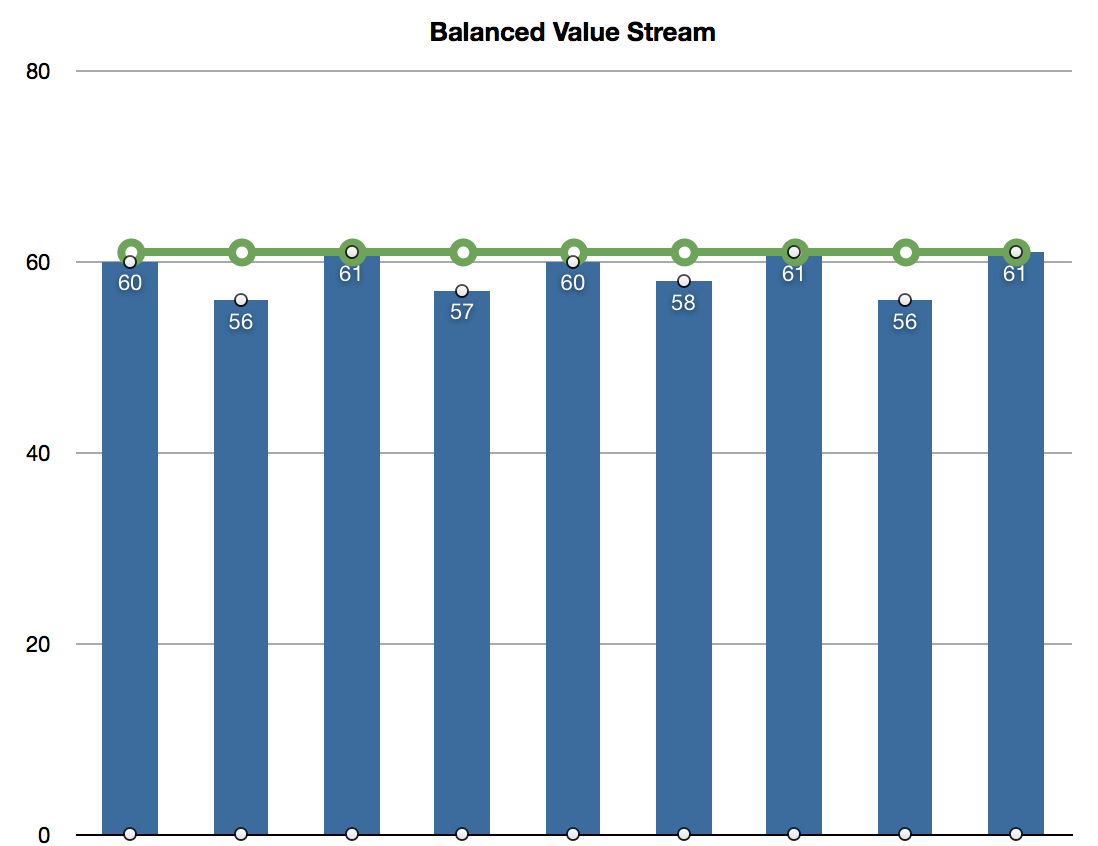
Unbalanced Value Stream – Mura
In my last post, Muri: Overburdening People and Equipment, I examined Muri, or overburden. In this post, I’d like to address Mura, or “unevenness.”
The bar chart above is a perfect example of Mura (imbalance). The green line is Takt Time (TT), while the blue bars are each individual process step’s Cycle Time (CT). It’s easy to see the disparity.
For those not familiar with the concept of Takt Time, it is the pace at which you need to perform every process step in order to meet customer demand. Corollary: Anytime CT is greater than TT, you cannot meet customer demand without overtime.
In the first third of the value stream (above), the processes all take far less than Takt Time. Then we get to the fourth process and things go haywire.
If you were walking through your plant what would you expect to see? What would be the visual indication of imbalance?
INVENTORY! Scads of it.
Since the CT for each of the first three processes is below TT, you wouldn’t see any inventory ahead of them. These operators have it easy. It’s a breeze for them to keep up with demand.
However, you could expect to see a mountain of WIP ahead of process #4. Takt Time is 61 seconds, while step #4 is almost three times that (168 seconds). No matter how hard this operator works, it’s impossible to keep up.
Imagine how popular that makes them.
Keep that in mind when you think of “good” vs. “bad” employees. How much control does the operator at step #4 have over how long their process takes? Yet human nature would have us judge them as “not as good as” the other operators who all get their job done “on time.”
How about process steps 5-7? Even though each is over TT, each is faster than the preceding step, so they will actually be starved, no WIP ahead of them and finishing ahead of the next WIP arriving.
Think about it. You have people at steps 1-3, 5-7 & 9 who are all twiddling their thumbs, while the operators at steps #4 & 8 can’t keep up. Said differently,
You’re paying seven operators to do NOTHING. They are wasting time “waiting” on the previous operation. THAT is Mura.
So, does that mean you’re doomed? Absolutely not. This is where Heijunka comes in. The term means “load balancing; load leveling.” How does it work?
To balance the load of the nine process steps, we’d do a couple of things. First, we’d go through the current process and eliminate waste. This would involve conducting Standard Work Kaizens at every operation.
Once all the processes were standardized, we’d add up the new CT’s and divide the sum by TT. That tells us the optimal number of operators we need. The current sum of CT’s is 790 seconds. After the Kaizen’s, we were able to get that down to 530 seconds. 530 sec/61sec = 8.7 people.
Since we can’t hire 7/10 of a person, let’s assume that, for now, the value stream requires 9 people. That means one person per operation, with each process step taking 61 seconds (TT) or less.
Now starts the horse trading.
We begin by breaking down each process step into individual tasks, timing each of those tasks, then reassigning enough tasks to adjacent operations to bring them all under TT.
An example would help.
After our Kaizens, operation #1 still takes 27 seconds. That makes it 34 seconds under TT. Let’s say you are able to shift all the tasks from Step #2 and some of Step #3 to step #1. That brings step #1 up to 60 seconds (1 second below TT).. The rearranged task times for Step #1 would now look like this.

New task times for Step #1
So it would go, step by step, until all nine steps took TT or less. The chart that results (below) looks much closer to a string stretched above a picket fence. The pickets in the fence are very close to the same height (TT).

Balanced Value Stream
The line is now balanced. Every step can now be completed in TT or less, meaning we can meet customer demand without overtime.
Work can move from one operation to the next without needing inventory (WIP) buffers between them.
With no WIP between operations, you can move the operations closer together and pass the work from one station to the next (pass along). That shrinks the footprint of the Value Stream giving you new capacity, without building new brick & mortar.
So, let’s review what we’ve achieved:
- On-time delivery
- Eliminated overtime
- Eliminated WIP between operations
- Minimized wasted operator time
- Made a Pass Along line possible
- Created the opportunity for new building capacity without brick & mortar
All in all, not a bad day’s work.

